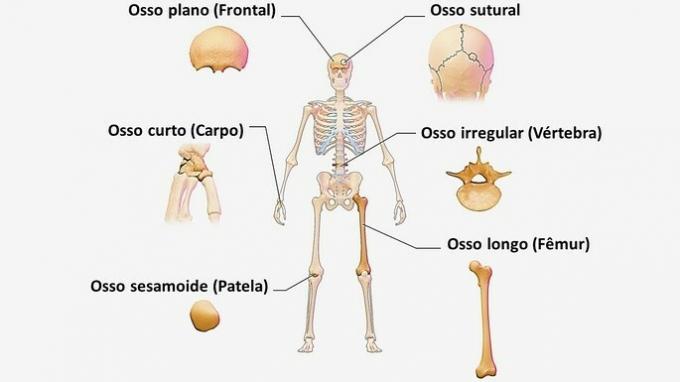The human skeletal system is made up of 206 bones classified according to shape and location.
By shape, bones are classified into five main types: long, short, plans, irregular and sesamoids.
Regarding location, the bones of the human body are classified into axial, making up the vertical axis of the body (head, trunk and neck). The other bones are appendicular, which form the upper and lower limbs.

long bones
They are bones whose length, despite being variable, is greater than its width and thickness. Furthermore, they are resistant due to their slightly curved structure to absorb the stress generated by body weight.
These bones are made up of a diaphysis, a body formed by compact bone tissue, and epiphases, which are the ends of spongy bone tissue.
Examples: femur, humerus, radius, ulna, fibula and phalanges.
short bones
They are bones formed by spongy tissue, whose surface has a thin coating of compact tissue. The shape of these bones is similar to a cube, as the length, height and width are practically equal.
Examples: Wrist bones (carpus) and ankle bones (tarsal).
pneumatic bones
Pneumatic bones have different characteristics from other groups and, therefore, are classified in a specific way. They have cavities, called sinuses, and are lined with air-filled mucous membranes.
Examples: Bones that are part of the skull, such as jaw and temporal.
laminar bones
They are also called flat bones or boring and provide protection. They are generally formed by two layers of compact tissue almost parallel and separated by a layer of spongy tissue, characterizing them as thin and compact bones of the body.
Examples: Skull bones such as frontal and parietal, ribs and scapula.
irregular bones
They are bones with a complex structure and variable composition of spongy bone tissue and compact bone tissue.
Examples: Vertebrae and calcaneus.
sesamoid bones
These are bones whose diameter can vary from millimeters to centimeters when they develop in certain tendons in the body, providing protection to regions that support friction, tension and physical stress.
A person may have a different number of sesamoid bones, however, they usually all have patellae, the largest sesamoid bones.
Examples: Patella located in the tendon of the quadriceps femoris muscle.
suture bones
Also called wormian bones, are classified as such because they are located between the joints, also called sutures, of the cranial bones. These are the supernumerary bones or accessories, which can grow in some people and not in others.
read aboutyouBones of the Human Body
Skeletal System Summary
The skeletal system, in addition to bones, is made up of other structures such as cartilage, ligaments and tendons.
Its main functions are:
- Support: makes the soft tissues support and structure the human body;
- Protection: prevents internal organs from being injured;
- Movements: skeletal bones and muscles act together, allowing movement;
- Mineral storage: Calcium and phosphorus are stored to give bone strength.
Learn more aboutSkeletal System
Bone structure
Bones are living structures that make up the bone system of the human body, being formed mainly by bone connective tissue.
There are two types of bones: compact, rigid part, and spongy, which is a less dense layer.
The anatomy of long bones, for example, is formed by:
- diaphysis: bone body;
- epiphases: bone ends;
- Metaphysis: intermediate region located between diaphysis and epiphases;
- Cartilage: is located on the epiphase and is responsible for reducing friction;
- Periosteum: thin membrane covering the bone;
- medullary cavity: inner bone space;
- endosteum: thin coating that surrounds the medullary cavity.
Learn more aboutbone tissue
human skeletal division
Altogether, the 206 bones that make up the bone structure of the human body are divided into two parts: axial skeleton and appendicular skeleton.
O axial skeleton it consists of 80 bones located in the central axis of the body and divided between the head, rib cage and spine. Its main function is to protect the central nervous system and organs in the rib cage region.
O appendicular skeleton it is formed by 126 bones divided between upper and lower limbs, being then responsible for carrying out movements and supporting the body.
Take the opportunity to check out our video lesson related to the subject:
To learn more about the bones of the body, these texts will help you:
- Skull Bones
- hand bones
- foot bones
- arm bones
- Exercises on the skeletal system

